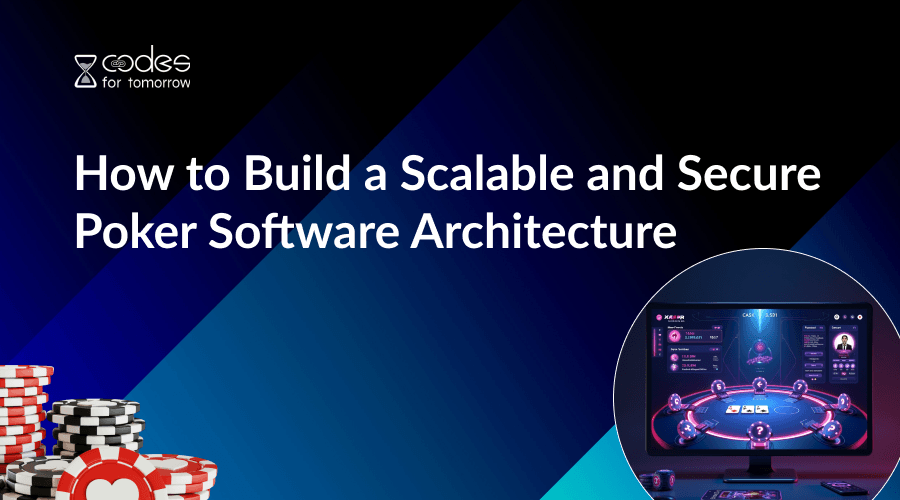110 A, Aditya Gateway Business Park MR 10, Indore, 452010, M.P. India
B-35, Veena Nagar, Near MR 10, Sukhliya, Indore, 452010, M.P. India

In today's fast-evolving iGaming landscape, building a successful poker platform goes far beyond just the gameplay. It's about developing a secure, scalable system capable of supporting thousands of users in real time. Whether you're a tech founder, product manager, or investor, understanding the architecture behind such platforms is key to ensuring performance, trust, and global reach.
This guide covers essential technical and business components from real-time communication to modular backend design to help you build a future-ready poker game software platform that delivers both seamless user experience and long-term reliability.
A poker room can't thrive on game play alone it takes a sound tech base and smart business strategy to grow up, stay secure, and provide globally.
Key Focus Areas
The ideal mix of technology and strategy turns poker platforms scalable, secure, and future-proof.
As more poker players go online and more foreign tournaments become available, the sites should be capable of handling heavy traffic without lag or downtime. Scalability will keep the system scaling with demand and still play smoothly and give a consistent user experience.
Key Focus Areas
Scalability is an imperative for a poker platform to sustain rising demand by users, maintain performance, and enable growth efficiently, delivering player satisfaction and business growth.
From a technology perspective, a future-proof poker platform needs to:
Choosing the right tech stack, cloud-based server infrastructure, and a modular development approach will help you scale effectively and maintain high performance. Modular architecture, in particular, allows you to roll out new features or enter new markets without costly rework, something every reliable poker software development company should offer.
From a business standpoint, planning should include:
Success hinges not only on solid engineering but also on smart business decisions, like integrating localized payment options, acquiring licenses, and offering engaging user experiences that drive loyalty. This is where poker game development services can add significant value for emerging brands.
These are the critical technology components your poker software must include to ensure real-time gameplay, scalability, security, compliance, and seamless user experiences:
1.Game Engine
Powers game logic, animations, and player interactions. It enforces rules and ensures smooth, consistent gameplay across sessions and devices.
2.Real-Time Communication Layer
Facilitates instant data exchange for live gameplay, chat, and player actions. It reduces latency and keeps gameplay fluid and engaging.
3.Scalable Server Infrastructure
Uses cloud-based servers that automatically scale resources up or down based on traffic. This keeps your platform fast and reliable, even during peak times.
4.Modular Backend Architecture
Separates features into independent modules (users, payments, gameplay, etc.). This makes updates and scaling much easier and safer, especially helpful when working with professional poker app developers.
5.Database Management
Handles secure storage and quick retrieval of user data, game history, and transactions. Supports both real-time operations and analytics.
6.Security Systems
Implements encryption, firewalls, and fraud prevention to protect users and ensure platform integrity.
7.Payment & Wallet Integration
Supports seamless deposits, withdrawals, and in-game transactions across multiple currencies and payment gateways.
8.Admin Dashboard & Monitoring Tools
Gives real-time oversight into user activity, system health, game performance, and revenue, helping operators make quick and informed decisions.
9.Compliance and Licensing Layer
Ensures legal operation across regions by managing licenses, enforcing age limits, and integrating responsible gaming protocols.
10.Analytics & Logging System
Tracks player behavior, system performance, and gameplay data for insights that drive UX improvement and operational efficiency.
11.AI-Powered Intelligence Layer
Applies machine learning for player personalization, fraud detection, gameplay balancing, and more intelligent business decisions.
To build a high-performance, secure, and responsive poker platform, you need to focus on these core architecture layers:
1.UI Layer (User Interface, Cross-Platform Support)
Delivers a smooth, consistent user experience across devices using responsive design and platform-specific UI optimizations.
2.Business Logic Layer
Manages rules and logic for gameplay, scoring, payments, and user actions. Keeps platform behavior consistent and easily maintainable.
3.Server-Side Layer
Processes user requests, manages multiplayer interactions, and ensures load balancing for real-time responsiveness.
4.Data Layer (DB, Caching, Logging)
Handles efficient data storage, fast access, and event logging for both operational monitoring and user analytics.
5.Security & Compliance Layer
Protects the platform from threats, manages authentication, and ensures adherence to gaming laws and standards worldwide. Essential for any poker software providers operating in regulated markets like online poker games in India.
A successful poker platform isn't just about the game it's about the system behind the scenes. To meet global demand and player expectations, you need a secure, scalable, and modular architecture that evolves with your business.
By focusing on real-time communication, cloud scalability, AI-powered intelligence, and compliance, you lay the groundwork for a robust platform that grows with your users and stands strong against challenges. With the proper tech foundation and business strategy, you're not just launching a poker game you're building a trusted global iGaming brand. Whether you're planning to hire poker game developers or partner with the best poker game development company, the choices you make today will define your platform's success tomorrow.